#UK amphibians and reptiles
Video
Viviparous Lizard (Zootoca vivipara) by Will Atkins
Via Flickr:
female
#Viviparous Lizard#Common Lizard#Zootoca vivipara#Zootoca#lacertid#Lacertidae#Wildlife#Wildlife of Europe#European Wildlife#Animal#Nature#animal portrait#reptiles#reptile#reptiles of Europe#European reptiles#lizard#Lizards#Lizards of Europe#British Wildlife#British amphibians and reptiles#British reptiles and amphibians#British reptiles#British lizards#UK wildlife#UK reptiles and amphibians#UK amphibians and reptiles#UK reptiles#UK lizards#Dorset wildlife
1 note
·
View note
Note
Can you share some good photos/resources of reptiles native to the UK?
UK REPTILES
Well, as you may know, there aren't that many reptiles native to the UK.
You have 3 snakes:
Grass snake, Natrix natrix
Adder, Vipera berus
Smooth snake, Coronella austriaca
and
You have 3 lizards:
Common lizard, Zootoca vivipara
Sand lizard, Lacerta agilis
Slow worm, Anguis fragilis
Some resources:
The British Herpetological Society (thebhs.org)
List of reptiles of Great Britain - Wikipedia
Reptiles & amphibians | Amphibian and Reptile Conservation (arc-trust.org)
ID Guide British reptiles – British Naturalists' Association (bna-naturalists.org)

Grass Snake (Natrix natrix), family Colubridae, England, UK
aka Ringed Snake or Water Snake
photograph by Mark Ollett
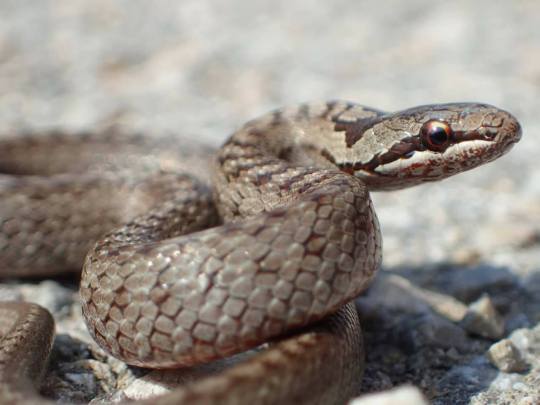
Smooth Snake (Coronella austriaca), family Colubridae, found in much of Europe
In the UK, this snake is found in limited locations in the South of England.
photograph by Mihai Si Furia Rosie


Sand Lizard (Lacerta agilis), female and male, family Lacertidae, found over much of Europe, and into western Asia
This lizard is found in isolated populations across the UK.
photographs by George Chernilevsky
148 notes
·
View notes
Text
There's a marked difference between how quickly mammals (including ourselves) age and how quickly many species of reptiles and amphibians do.
This discrepancy, one scientist proposes, could be due to the dominance of dinosaurs millions of years ago, during a critical period of mammalian history.
Microbiologist João Pedro de Magalhães from the University of Birmingham in the UK describes his "longevity bottleneck" hypothesis in a newly published paper.
Here's the thinking: when dinosaurs ruled Earth, it was necessary for the much smaller mammals to be able to reproduce quickly in order to survive, which means the genes for longer lifespans may have been discarded as evolution progressed.
"Some of the earliest mammals were forced to live towards the bottom of the food chain, and have likely spent 100 million years during the age of the dinosaurs evolving to survive through rapid reproduction," says de Magalhães.
"That long period of evolutionary pressure has, I propose, an impact on the way that we humans age."
Continue Reading.
177 notes
·
View notes
Note
I'm really sorry if you already answered but I did look through the whole lexicon and used control+f. Do we have words for Lizards/Newts//Salamanders/Reptiles?
I wanted to see the Clanmew names for 2 OCs Lizardsong and Salamanderclaw. The second being a Skyclan Daylight Warrior!
The word for reptile is "Skeep"! It is a wingless, typically scaled animal without fish "wings". So, it actually includes amphibians as well. This is because there are very few reptiles in the UK; Clan cats don't see why an amphibian is not simply a water-reptile.
So to them, a lizard is a four-legged reptile with a tail. It includes all of the newts that they encounter on a regular basis, even though these are technically amphibians. What are you gonna do, teach the cats cladistics?
Lizard (Generic) = Ssassa
Adult newts and lizards, without breeding season adornments. Has 6 species.
Sail (of a fish or a breeding male newt) = Saoss
The dorsal fins on top of a fish or a breeding male newt.
Viviparous Lizard (Zootoca vivipara) = Sipssa
Eggs are much rarer in this part of the world than you might think. Like its name suggests, the viviparous lizard typically gives live birth, which is likened to the adder. This is the most common lizard in the area, encountered by all Clans.
Sand Lizard (Lacerta agilis) = Hwoossa
Named for being seen mostly in WindClan's sandy lowland heath, because this IS an animal that lays eggs. It needs sunny, sandy areas to be able to hatch a brood.
Smooth Newt (Lissotriton vulgaris) = Fyenssa
A contraction of "Flame's Lizard," for the quirk where these newts will often hide in piles of cold, wet wood, only to flee out when a fire is lit. The most common newt to encounter, feel free to translate as "salamander!"
Palmate Newt (Lissotriton helveticus) = Horrssa
The "shade newt," so named because this one generally prefers forested, green areas. Its tail is much fatter than the other newts.
Great Crested Newt (Triturus cristatus) = Gisis
What was once the Tribemew word for all lizards now only describes the great crested newt, the largest and most respected of the "lizard" classification. An accomplished hunter with an impressive sail during its breeding season, on both the back and the tail.
Some extra facts about newts and lizards in general...
Scientifically, all newts are salamanders, but not all salamanders are newts. You could translate any one of these words as "salamander."
Through their lives, newts will have terrestrial phases and aquatic phases.
Britain's cold climate and isolation as an island means there are very few reptiles in general; amphibian species outnumber them because it is very wet.
Slowworms are technically a lizard, but Clan cats believe they are a snake.
Clan cats also believe that snakes were not originally reptiles, but worms. There is a story about a cat who hunted them to extinction and then had to recreate them from memory, forgetting that worms don't have scales.
55 notes
·
View notes
Text

Happy Trans Day of Visibility!
Hope you all have a safe and much loved day
Theres a few creatures out there that can manipulate thier genders. Fish, Molluscs and even some Reptiles and Amphibians but probably my favourite example is not so much a change for breeding survival as far as reproduction goes.
Its one I think is far more fitting for the way that humans present themselves. The Marsh Harrier, this Bird of Prey is the biggest of the Harriers in the UK. Locked into the south of England they became the target of persecution until just one nesting female remained. Now thats to efforts to save this largley migratory bird have seen a rise to over 400 breeding pairs since the 1970s.
They are easily recognisable, fantastically coloured and a very characteristic V shaped wing position in the sky. The unforgettable awe inspiring tumble between pairs in courtship displays of talon locking. This species is sexually diamorphic. The females are larger a smooth brown plumage with a dense golden crown and throat. The males are usual are most intensely coloured long grey wings that extend out into black tips, a pale neck and head trailing back into a gingery underside and a brown upper
Interestingly though there's some levels of change. At thier first moult in winter their juvenile plumage can make things a little murky, now the first full body moult at 2cy can make them sexually distinguishable. However come the summer of that cycle males can start looking remarkably like females, even into the summer of 3cy. Now whilst these males cant match the size of the females they do blend in rather well. Then some of the older females cam develop male type plumage and some birds even keep an almost juvenile plumage
So I think its a casing point to say you just have to do you. Whilst gender identity and gender expression are two different things I think gender expression goes a long way to help folk feel comfortable in thier own skin
It might be the males adopt a female cover for protection, it could be older females want to be left alone by males we dont know but its doesnt change the fact whatever the reason they are still worthy of protection and admiration
31/03/24
#vulture culture uk#vulture culture#oddities#taxidermy#bones#skull#skull collecting#animal skull#curiosities#tdov#tdov 2024
18 notes
·
View notes
Text
Here’s some sad news: the Scottish Wildcat (Felis silvestris silvestris) is now genetically extinct due to interbreeding with domestic cats.
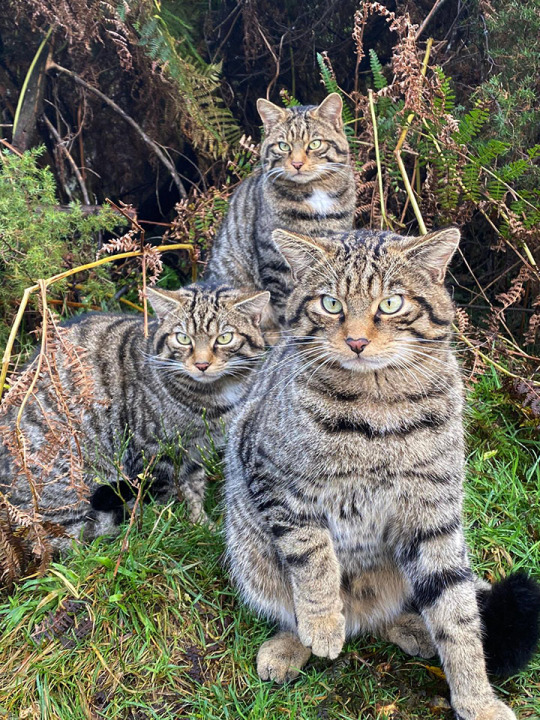
(Photo credit: Project Saving Wildcats)
The Scottish Wildcat was a subspecies of European Wildcat that lived in the highlands and forests of northern and eastern Scotland for thousands of years. For the past 2,000 years they lived alongside domestic and feral house cats without too much interbreeding going on according to genetic analysis of wildcat fossils. However, around 70 years ago the wildcats and house cats started interacting more since the wildcats were rapidly losing habitat. House cats began breeding with the wildcats and now their populations have become so intertwined that the species is now genetically extinct. This is yet another reason as to why you should not let you pet cats outside without supervision, or at the very least spay and neuter them! Over 63 species of birds, mammals, reptiles, and amphibians have been hunted to extinction by cats and that number is only growing. Cats are one of the most destructive invasive species in the world, and this is coming from a cat lover!!!
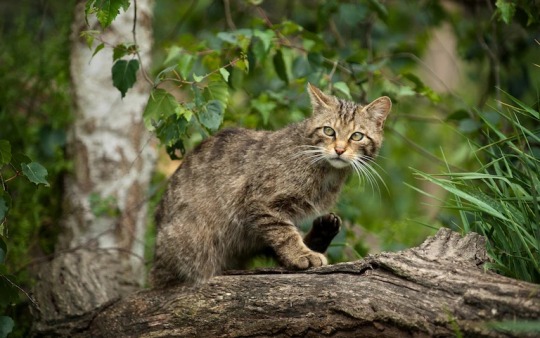
(Photo credit: Charlie Bishop)
However, there is some hope. There are efforts to try to breed genetically pure Scottish Wildcats in captivity and release them into the wild as well as talks of bringing in different subspecies of European Wildcats to help bring in more genetic diversity into the population. Sadly, rewilding projects in general are facing a lot of pushback and this is especially true in the UK.
31 notes
·
View notes
Text
actually the rspb website is a great resource for anyone that wants to mention british wildlife (in particular birds) in their fics and they're unsure of the variety of little funky birds we have over here.
have another link to the website.
the woodland trust is a wonderful resource for the various animals we have in the uk too. they cover various species of birds, mammals, reptiles and amphibians you can find (as well as my beloved insects). they also have a handy tree identification guide.
have a link to the woodland trust website.
#pfh talks about england#i'm not sponsored by or working for either of those organisations#i just think they might be a good resource for those that are curious#but in the spirit of honesty i am a member of the rspb for £5 a month because birds are lovely
15 notes
·
View notes
Note
I am pretty sure we have 3 snakes and a lizard that looks like a snake in Sweden, but I know next to nothing about them! I’m not even sure of all their names. Could you tell me about them? I can recognize the black one with yellow on the head I think it’s very cute and non-venomous
You're exactly right, there are three snakes native to Sweden! They're the same three that are native to almost everywhere in Europe, and they're the only three up in Sweden (and the UK!) because they're the ones that tolerate colder temperatures best.
The grass snake (Natrix natrix) is the one you recognize (and they are indeed very cute and non-venomous)! These little guys will play dead when they feel threatened, just like hognoses. You can usually find these guys near water, and they eat almost exclusively amphibians. They're the only snake in Sweden that lays eggs!

Smooth snakes (Coronella austriaca) are the other non-venomous snake you can find in Sweden! You can tell them apart because, as their name implies, they have smooth scales! Smooth snakes almost exclusively eat other reptiles - in Sweden, their diet is mostly lizards.

Finally, Sweden's only venomous snake is the common European viper (Vipera berus). They're easily recognized by their zig-zag patterns. Although they're venomous, they're not considered super dangerous and bites are almost never fatal (obviously go to the hospital if you're bitten anyway!). They have a very common black color phase, so if you see an all-black snake, it's probably a common viper!

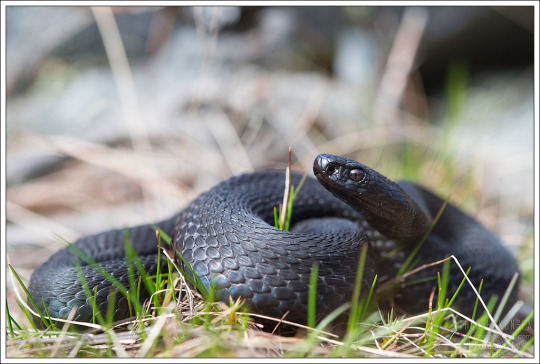
Bonus not-snake: the legless lizard native to Sweden, the slow worm (Anguis fragilis)! You can tell slow worms apart from snakes by their lizard characteristics: they have external ears and eyelids, and they move in a way that's noticeably more clumsy than snakes.
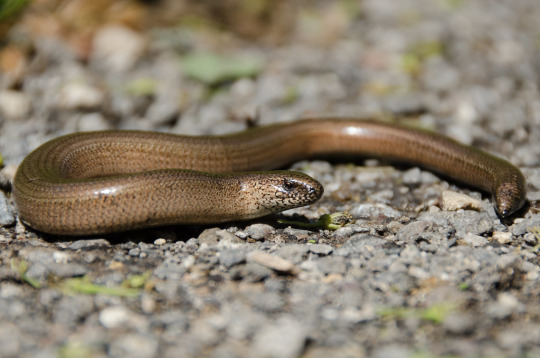
121 notes
·
View notes
Text
Planet Zoo ideas!
For if you are burnt out or don't know what to make! ♡
1) Monkey World! ♡
Create a zoo full with only primates! I got this idea from the Mokey world ape rescue centre in Dorset I use to visit all the time as a kid! It's also incredibly fun to make enclosures for these animals in game!
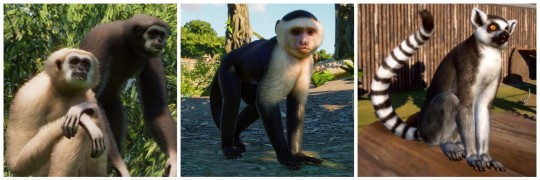
2) Reptile House! ♡
Create a massive building full of reptiles! This is a fun challenge because it makes you improve on creating buildings as well as utilising exhibits! I also LOVE making habitats for the monitors! You could also add amphibians and insects because in most reptile houses they usually also have them!
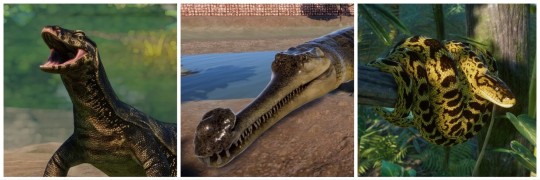
3) New Zoo! ♡
Create a zoo in a biome you have never or don't use often and fill it with animals you have never made habitats for! This is a good idea for me personally because half of my zoos are African and I really need to branch out! I make too many enclosures for lions and meerkats! Here are some animals I have never seen someone use in planet zoo!
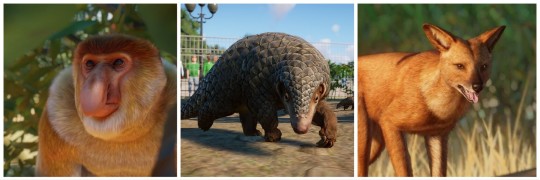
4) Where are you from? ♡
Make a zoo based on where you are from! Select your country and biome and fill it up with animals that live there! (If you are from the uk like me I suggest just making a European zoo because there isn't many native British animals in game.)

5) Big Cat Sanctuary! ♡
Create a sanctuary or a rescue centre for cats! There are quite a few in the game right now from all around the world! This will help becoming better at mixing themes in one zoo!
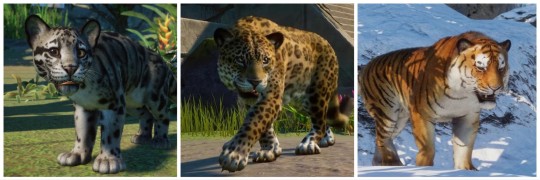
If you do any of these, reblog and show me <3
#Sylveonyie#Sylveonyie Challenge#Sylveonyie Posts#Sylveonyie Zoos#Sylveonyie Games#Planet Zoo#Planet Zoo Challenge#Monkey World Challenge#Reptile House Challenge#New Zoo Challenge#Where Are You From Challenge#Big Cat Sanctuary Challenge
6 notes
·
View notes
Text
Against so-called "mpreg"
Heteronormative ideology is pervasive and persistent, the unrelenting and insidious essence of which is further aimed at the public through a genre called "mpreg" that maintains limited, heterosexist roles (e.g. one becomes "pregnant" and another "impregnates")
So-called "mpreg" is "who’s the man and who’s the woman in the relationship" at its worst taking a nosedive. Whoever has an issue with the "seme/uke" trope, should have an issue with so-called "mpreg"
The "to-be-pregnant" character that is claimed to be a "man" is a woman, acts like a woman, yields to the "gender" roles that affect women and their perceptions of themselves and experiences what women experience. The character is in no way a man
So-called "mpreg" is not only homophobic, but also discriminatory against the childfree movement. Its "creators" and consumers can not fathom that one can build a happy, healthy relationship without "kids"
The lack of media and literature depicting gay relationships is an issue. And so-called "mpreg" and "futanari" rub salt into the wound. They are "straight" media and literature disguised as gay, and women’s "pregnancies" disguised as so-called "men’s pregnancies"
So-called "mpreg" and "futanari" should be banned as genres. No material, video, animation, comic, literature, game, etc, should depict such an abomination
To the people who accuse me of "kink shaming" them: my kink is kink shaming and you’d be shaming my kink. Why wouldn’t I shame yours?
To the people who appeal to seahorses, pipefishes, etc: https://imgur.com/UcmJi2Y
"Fish, reptiles, amphibians, and birds don't actually get "pregnant" in the sense that mammals do. In species with internal fertilization, the offspring is nourished entirely by the egg, not by either parent or a placenta, until it hatches. In fish and other species with primarily external fertilization (some fish are internal), the female lays eggs and "f*cks off" while the male deposits sperm and carries the eggs"
"The male does not produce a placenta or nourishment for the offspring and is therefore not pregnant, in the same way that if I carry around a hamster in my hands, I am not pregnant with said hamster, and if I carry gum in my mouth, I am not pregnant with said gum. The pouch is not the same as a uterus in structure or function. After hatching, offspring return to the pouch when confronted with a threat. Other male fish look after fertilized eggs in nests they've made or in their mouth. The nest is not pregnant, nor is the mouth"
The biologist takes the words out of my mouth. No male in any specie can become "pregnant"
The male seahorse or pipefish, for instance, has a pouch in which fertilized eggs are deposited. It’s not a womb. It’s like a bag. For something to be "pregnancy," the body of a female and placenta are required
Definition of "pregnancy": the time during which one or more offspring develops inside a female's womb
No male has a womb. What males experience can not be considered "pregnancy". And no, a male seahorse or pipefish has no womb or else it wouldn’t be a male. A womb is a female organ that a male can not have
The so-called "scientists" that claim a male seahorse or pipefish is "pregnant" use "pregnancy" as a metaphor. They are not literally "pregnant"
It's incorrect to use the term on non-mammals. They function differently in the area. Fertilized eggs residing in a pouch is not "pregnancy" as much as bacteria residing in male human guts doesn't mean every male human in existence is "pregnant"
To claim male pipefish, seahorse, etc are "pregnant" renders "pregnancy" meaningless. Anything would be "pregnant" in that case; including a coffee mug with a roach inside it. And that’s beyond ridiculous
More on why so-called "mpreg" is bulls*it: https://imgur.com/bcQNSzQ
Sincerely, an anti-"mpreg" enthusiast!
#gay#gender critical#terf#radfem#radical feminism#female separatism#antinatalism#childfree#anti mpreg#antimpreg#anti straight#antistraight#anti trans#antitrans#activism#science#biology#media#anime#manga#manhwa#comic
15 notes
·
View notes
Text
Hey!
I've mostly posted on Instagram but since I've been on Tumblr way longer I wanted to actually start up here!
I follow from @starlightorchestra and if you're a reptile/amphibian fan then I have a pet blog @fellowshipofthenoodles ❤️
About:
30s. Queer. UK. Disabled. Neurodivergent.
DID system (will use we often and draw art related to our alters)
Witchy. Reader. Gamer. Reptile keeper.
No niche, we can't decide a specific thing to draw and it's more fun to do what we want anyway - expect furry, feral, humanoids and herps
Using Clip Studio Paint on a Windows Surface Go
No commissions unless we're friends (Sorry!) - No requests unless we say otherwise (happy to hear suggestions though!)
We never draw NSFW, our art is safe for all ages
We do have an Etsy shop
Our art is tagged with #squishyfauna but we want to reblog from other artists here too and share the love!
We have a Discord for mentally ill artists
DNI:
Anyone drawing feral NSFW
Anyone drawing sexual images of underage characters
Racists, nazis, sexists, ableists, homophobes, transphobes, TERFs, SWERFs, gender critical, trans med (probably other but hey, if we don't like what we see we use the block button liberally).
1 note
·
View note
Text
Guide on Moving House With Pets

Website: www.vansandhands.com
Moving homes with pets can be confusing and anxiety-inducing for pets. To ensure a smooth transition, it is essential to visit your current veterinarian, arrange a separate room or space for pets, and consider other options like hiring a pet sitter or booking a kennel or cattery. Ensure your pet is tethered securely in your vehicle and has all necessary vaccinations.
Read Top Tips for Moving Homes with Pets in the UK, to learn more.
Take a stroll around your new neighborhood in the days leading up to the move to help them adjust to new situations. Let home moving services in London know about any pets moving with you upfront, especially if you are transporting exotic species like tropical fish, reptiles, or amphibians.
On D-day, use pheromone diffusers to help pets relax and avoid anxiety. Regularly check in with your pet, lock any doors and windows behind you, and provide them with clean water and toys to keep them occupied. Plan meals carefully, avoiding feeding your pets two hours before the move to prevent travel sickness.
To move homes with pets in the UK, it’s essential to stay at home for the first few days, update their details, be patient, and ensure each room is secure. Keep cats indoors for a week, and alert former neighbors about the move if they see them. If your pet exhibits signs of sadness or depression, seek expert assistance. Be gentle with your pet and don’t panic!
#moving house with pets#moving home with a dog#tips for moving with a cat#moving home tips#home moving services in Kent#home moving services in London#Question to ask a moving company#House moving checklist#guide for small move#man with a van in Kent#vans and hands
1 note
·
View note
Text
Celebration Of Dragons In The Hills As Project Comes To An End
Celebration Of Dragons In The Hills As Project Comes To An End
@nmdcouncil @TNLUK #DragonsInTheHills
Over the last three years, the Dragons in the Hills project has sought to discover more about Northern Ireland’s little dragons – our three native amphibians and reptiles: common frog, common lizard and smooth newt.
The project, which is led by Amphibian and Reptile Groups of the UK in partnership with Newry, Mourne and Down District Council and The Herpetological Society of Ireland, is now…

View On WordPress
0 notes
Text
In Heat: Climate Change’s Cold-Blooded Disruption of Animal Reproduction

Climate change is having a profound effect on the world around us. Many are well talked about like increased forest fire activity, heat waves, and droughts. But there are many subtler and equally disastrous changes afoot for worsening the biodiversity crisis. One of the lesser-known impacts is the effect rising temperatures has on the sex ratios of amphibians and reptiles. As the Earth's temperatures continue to fluctuate in extreme ways, it causes significant changes in the ratio of females to males being born for certain species. An out-of-sync ratio has obviously serious implications for the future of these species and the ecosystems they inhabit as reproduction is impacted.
In many species of amphibians, the sex of an individual is determined by the temperature of the environment during a critical period of development. This is known as Temperature-dependent Sex Determination (TSD). In species with TSD, warmer temperatures during development typically result in more females, while cooler temperatures result in more males. This process is essential for maintaining healthy populations of amphibians, but it is also highly sensitive to changes in temperature.
As global temperatures continue to rise, this delicate balance is being disrupted, leading to significant changes in the sex ratios of amphibians. In some cases, warmer temperatures are causing a disproportionate number of females to be born, which can lead to a lack of genetic diversity and reduce the overall fitness of the population. In other cases, cooler temperatures are resulting in a greater number of males, which can lead to competition for mates and further reduce genetic diversity.
One of the most well-studied examples of this phenomenon is the red-eyed treefrog (Agalychnis callidryas), a species found in Central and South America. Researchers have found that as temperatures increase, more females are being born, and the ratio of males to females is becoming increasingly imbalanced. Another example, a study of the European Common Frog (Rana temporaria) in the UK found that warmer temperatures resulted in a higher proportion of females. Similarly, a study of the Western Chorus Frog (Pseudacris triseriata) in Canada found that warmer temperatures resulted in fewer males. Similar effects are found on Sea Turtle populations and other reptiles.
In addition to TSD, some species have genetic sex determination, where sex is determined by the presence or absence of certain chromosomes. However, even in species with genetic sex determination, temperature can still play a role in determining sex. For example, researchers have found that exposure to warmer temperatures during development can cause male-typical gene expression patterns in female embryos of frogs.
Amphibians are a diverse group of cold-blooded animals that rely on their environment to regulate their body temperature. This makes them particularly vulnerable to changes in their habitat. Beyond sex effects, temperature fluctuations caused by climate change stand to devastate the population.
The effect of climate change are much more complicated than they may seem on the surface. As global temperatures continue to rise, the delicate balance of TSD is being disrupted, resulting in imbalanced sex ratios and reduced genetic diversity. This could have serious implications for the long-term survival of amphibian populations, which are already facing numerous threats, including habitat loss, pollution, and disease.
When you join Life After Life you save two frogs with one stone - you secure a sustainable death care plan for your loved ones, and you increase green space and endangered habitat in your community. In addition to being the most energy efficient way of sequestering carbon at the root of climate change, developing lush park spaces combats the heat island effect in metropolitan areas, cooling down the surrounding area.
#life after life#conservation#climate change#climate crisis#amphibians#sex ratio#science#nature fact#animal fact#symbiosis#biodiversity#sustainability#green living#green burial#transcend#death positive#one last good deed#think long term#natural burial#cemetery#conservation cemetery#memorial park
0 notes
Text
The Pond Builders
Ponds are one of the most popular features in British gardens, and for a good reason. They provide a haven for wildlife, a place to relax, and an opportunity to get closer to nature.
Ponds are a great addition to any garden, providing a place for wildlife, relaxation, and escape from the hustle and bustle of everyday life. But did you know that ponds can also play an essential role in water conservation?
Ponds are a great way to store rainwater, which can be used to water plants during dry periods. They can also be used to top up swimming pools and water features or for irrigation. We can reduce our reliance on mains water by using ponds to store water and help conserve this vital resource.
How Pond Builders helps build ponds in the UK
Pond builders is a company that helps build ponds across the UK. We work with individuals, businesses, and organizations to create custom-built ponds that are both beautiful and functional. Our team of experts has years of experience in pond design, construction, and maintenance, so you can rest assured that your pond will be built to last.
Modern technology
We use the latest technology and materials to build our ponds, ensuring that they are built to withstand the British weather. Our ponds are also low maintenance, so you can enjoy your pond without worrying about constantly cleaning it.
Flexibility
We understand that every garden is different, so we offer a range of pond sizes and styles to choose from. We can also create custom-built ponds to suit your specific needs. The ponds we build can be used for various purposes, such as fish breeding, irrigation, or simply as a water feature.
Affordability
We believe that everyone should be able to enjoy the benefits of a pond, which is why we offer competitive prices. We also provide a range of financing options to make it easier for you to afford your dream pond.
Creating a haven for wildlife
Ponds provide vital habitats for many wildlife species, including amphibians, fish, reptiles, birds, and mammals. Creating a pond in your garden will provide a home for these animals and help support the local ecosystem.
Pond Builders can help you create the perfect pond for your garden. We offer a range of sizes and styles to choose from, as well as custom-built ponds to suit your specific needs.
The Pond Builders team is passionate about ponds, and we would love to help you create one in your garden. Contact us today to learn more about our services or get a free quote.
#pond#ponds#pond builders#pond construction#pond building#pond company#ponds uk#pond builders uk#uk pond
1 note
·
View note
Text
Meopham photographer captures incredible moment grass snake eats a marsh frog tadpole, at Oare Marshes, near Faversham
New Post has been published on https://petnews2day.com/pet-news/small-pet-news/meopham-photographer-captures-incredible-moment-grass-snake-eats-a-marsh-frog-tadpole-at-oare-marshes-near-faversham/
Meopham photographer captures incredible moment grass snake eats a marsh frog tadpole, at Oare Marshes, near Faversham
A retired gas engineer turned photographer has captured the incredible moment a three-foot grass snake devoured a marsh frog tadpole for its lunch.
Steve Cullum, who is from Meopham, captured the images at Oare Marshes nature reserve near Faversham.
A grass snake was pictured eating a marsh frog tadpole. Picture: Steve Cullum/Solent News
The 69-year-old said: “I was with other members of our local Gravesend RSPB nature watch group and these shots were taken at part of the reserve called Dans Dock.
“The snake was about three feet long and was swimming about with another one, when it suddenly dived and came up with a marsh frog tadpole in its mouth.”
Grass snakes are Britain’s largest snake, and hunt amphibians, fish, small mammals and birds.
They are usually found in wetland habitats, but can also be seen in dry grasslands and in gardens – especially those with a pond nearby.
The Oare marshes are managed by Kent Wildlife Trust, and the reserve consists of over 81 hectares of grazing marsh, open water scrapes, reedbed, saltmarsh and seawall.
Grass snakes are Britain’s largest snake. Picture: Steve Cullum/Solent News
The grass snake was three feet long. Picture: Steve Cullum/Solent News
The marshes also homes other reptiles, such as the sand lizard, slow worm and adder – which is the UK’s only venomous snake.
The shots were captured in August by Steve using his Nikon D500 camera, with a 500mm pf lens.
He continued: “It took a while to devour its lunch, then slithered away, back amongst the reeds.”
Steve has became an avid nature photographer and regularly visits wildlife sites around the county.
0 notes
